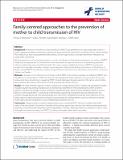| dc.contributor.author | Abrams, Elaine J | |
| dc.contributor.author | Fawzi, Mary C Smith | |
| dc.contributor.author | Stichick, Theresa Stichick | |
| dc.contributor.author | McBain, Ryan Keniston | |
| dc.date.accessioned | 2010-11-04T20:41:23Z | |
| dc.date.issued | 2010 | |
| dc.identifier.citation | Betancourt, Theresa S., Elaine J. Abrams, Ryan McBain, and Mary C. Smith Fawzi. 2010. Family-centred approaches to the prevention of mother to child transmission of HIV. Journal of the International AIDS Society 13(Suppl 2):S2. | en_US |
| dc.identifier.issn | 1758-2652 | en_US |
| dc.identifier.uri | http://nrs.harvard.edu/urn-3:HUL.InstRepos:4522598 | |
| dc.description.abstract | Background: Prevention of mother to child transmission (PMTCT) programmes have traditionally been narrow in scope, targeting biomedical interventions during the perinatal period, rather than considering HIV as a family disease. This limited focus restricts programmes' effectiveness, and the opportunity to broaden prevention measures has largely been overlooked. Although prevention of vertical transmission is crucial, consideration of the family environment can enhance PMTCT. Family-centred approaches to HIV prevention and care present an important direction for preventing paediatric infections while improving overall family health. This paper reviews available literature on PMTCT programmatic models that have taken a broader or family-centred approach. We describe findings and barriers to the delivery of family-centred PMTCT and identify a number of promising new directions that may achieve more holistic services for children and families. Methods: Literature on the effectiveness of family-centred PMTCT interventions available via PubMed, EMBASE and PsycINFO were searched from 1990 to the present. Four hundred and three abstracts were generated. These were narrowed to those describing or evaluating PMTCT models that target broader aspects of the family system before, during and/or after delivery of an infant at risk of acquiring HIV infection (N = 14). Results: The most common aspects of family-centred care incorporated by PMTCT studies and programme models included counselling, testing, and provision of antiretroviral treatment for infected pregnant women and their partners. Antiretroviral therapy was also commonly extended to other infected family members. Efforts to involve fathers in family-based PMTCT counselling, infant feeding counselling, and general decision making were less common, though promising. Also promising, but rare, were PMTCT programmes that use interventions to enrich family capacity and functioning; these include risk assessments for intimate partner violence, attention to mental health issues, and the integration of early childhood development services. Conclusions: Despite barriers, numerous opportunities exist to expand PMTCT services to address the health needs of the entire family. Our review of models utilizing these approaches indicates that family-centred prevention measures can be effectively integrated within programmes. However, additional research is needed in order to more thoroughly evaluate their impact on PMTCT, as well as on broader family health outcomes. | en_US |
| dc.language.iso | en_US | en_US |
| dc.publisher | BioMed Central | en_US |
| dc.relation.isversionof | doi:10.1186/1758-2652-13-S2-S2 | en_US |
| dc.relation.hasversion | http://www.ncbi.nlm.nih.gov/pmc/articles/PMC2890971/pdf/ | en_US |
| dash.license | LAA | |
| dc.title | Family-Centred Approaches to the Prevention of Mother to Child Transmission of HIV | en_US |
| dc.type | Journal Article | en_US |
| dc.description.version | Version of Record | en_US |
| dc.relation.journal | Journal of the International AIDS Society | en_US |
| dash.depositing.author | McBain, Ryan Keniston | |
| dc.date.available | 2010-11-04T20:41:23Z | |
| dash.affiliation.other | SPH^Francois Xavier Bagnoud | en_US |
| dc.identifier.doi | 10.1186/1758-2652-13-S2-S2 | * |
| dash.authorsordered | false | |
| dash.contributor.affiliated | McBain, Ryan Keniston | |
| dash.contributor.affiliated | Betancourt, Theresa | |


